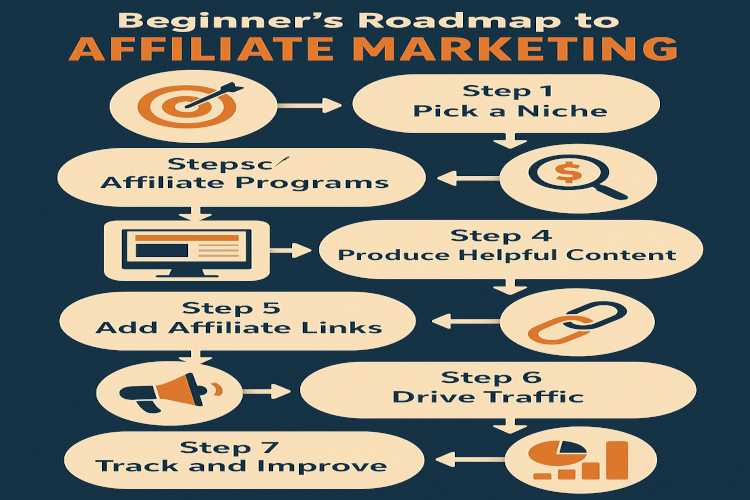
Affiliate Marketing Fundamentals: A Complete Guide for Beginners (Article: 1 of 25)
Affiliate marketing isn’t magic. It’s not a “get rich quick” scheme. It’s a business model, one that works very well when you treat it like an actual business. In this guide, we’ll break it down into plain language so you can get started without the usual confusion, hype, or snake oil.
What Is Affiliate Marketing? Business Models Explained
At its core, affiliate marketing is getting paid to recommend other people’s products or services. You send potential customers to a merchant through a unique link (your “affiliate link”), and if they buy, you earn a commission.
There are three main business model flavors:
-
Pay Per Sale (PPS) – You earn when the person you referred makes a purchase.
Example: Amazon Associates, you link to a product, and if someone buys, you get a percentage. -
Pay Per Lead (PPL) – You earn when your referral completes a specific action like filling out a form, signing up for a trial, or requesting a quote.
Example: Insurance lead programs - you send someone to fill out a quote form, you get paid. -
Pay Per Click (PPC) - You earn for each click sent to the advertiser, regardless of whether they buy.
Example: Less common in modern affiliate programs but still used in niche display advertising.
Key Players: Merchants, Networks, Publishers
Affiliate marketing works because different parties benefit from the same transaction. The main players are:
-
Merchants (Advertisers) – The companies selling the product or service. They want more customers without paying for traditional ads up front.
-
Networks – The middlemen that manage offers, track clicks and sales, and handle payments.
Examples: ShareASale, CJ Affiliate, ClickBank. -
Publishers (Affiliates) – That’s you. You create the content, promote the products, and drive traffic through your links.
Pros, Cons, and Realistic Income Timelines
Pros
-
Low startup cost - no product creation, no inventory.
-
Location independence - work from anywhere with internet.
-
Unlimited niche opportunities - from cooking to crypto.
-
Scalable - your income can grow with your traffic.
Cons
-
Not instant - takes months to see meaningful income.
-
Reliance on third-party rules - programs can change or close.
-
Competition - popular niches are crowded.
-
Learning curve - traffic generation, SEO, and copywriting skills take time.
Realistic Timeline to Income:
-
0–3 months: Learning, building your platform, little to no income.
-
4–8 months: Small commissions, often under $100–$300/month.
-
9–18 months: Consistent earnings for those who stick with it, possibly $1,000+/month.
-
2+ years: Potential for significant income if you scale traffic and diversify offers.
Step-by-Step Setup Checklist
-
Pick a Niche – Choose something you can write or talk about consistently and that has proven products.
-
Research Affiliate Programs – Look for merchants or networks in that niche with competitive commissions.
-
Create a Platform – Website, blog, YouTube channel, email list, or social account.
-
Produce Helpful Content – Tutorials, reviews, comparisons, and guides.
-
Add Affiliate Links – Naturally integrate them into your content.
-
Drive Traffic – SEO, social media, paid ads, partnerships.
-
Track and Improve – Use analytics to see what’s working.
Measuring Early Success (Basic KPIs)
When you’re just starting, focus on these Key Performance Indicators:
-
Click-Through Rate (CTR) – Percentage of people clicking your affiliate links.
-
Conversion Rate – Percentage of clicks that lead to sales or leads.
-
Earnings Per Click (EPC) – Average amount you earn for each click.
-
Traffic Growth – Number of visitors or viewers over time.
-
Content Output – Number of new posts, videos, or emails created.
Pro Tip: In the first 6 months, judge your progress more by traffic growth and engagement than by commissions. The money follows the audience.

